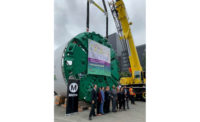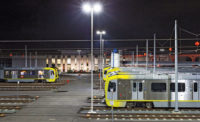A five-year odyssey beneath the streets of Los Angeles reached an end as a duo of tunnel boring machines named “Aura” and “Iris” reached the conclusionof their journeys earlier this year. Their arrival marked the end of the tunneling on the third and final section of The Los Angeles County Metropolitan Transportation Authority (Metro)'s $9.5 billion D Line Subway Extension Project earlier this year.

Read ENR Transportation Editor Aileen Cho's report on Metro's D Line's Section 2 and the unique obstacles the contracting team faced.
Intrepid Tunneling Through a Maze of Gas and Tar in LA
The nine-mile-long expansion is a step forward in Metro’s plan to build a subway connecting Downtown Los Angeles with a new Westwood/VA Hospital Station.
“The D Line Subway Extension is one of the most complex engineering feats that Metro has undertaken,” said Lindsey Horvath, Chair of the LA County Board of Supervisors and Metro Board Member in a ceremony marking the achievement on April 2.
For the tunneling aspect of the project, contractors used Tunnel Boring Machine (TBM) technology to excavate approximately 40-60 feet per day. The 400 foot-long, 21 foot-diameter Herrenknecht earth digging machines utilized on Section 3 featured closed face, pressurized TBM technology that minimizes ground settlement during excavation.
“This safe completion of tunneling through this part of Los Angeles is a milestone in Metro’s work to expand fast and reliable public transit across the region,” said Karen Bass, L.A. City Mayor and Metro Board Chair said at the completion ceremony.
Continuing where the Purple Line currently ends at Wilshire / Western station in Koreatown, the project will add seven new stations in some of LA’s busiest destinations such as the Miracle Mile, Beverly Hills, Century City, and Westwood. When the project is complete, riders will be able to travel between downtown Los Angeles to Westwood in only 25 minutes.
With tunneling complete, Metro says it will continue working with its JV contractors, Skanska-Traylor-Shea and Tutor-Perini/O&G, to complete seven new underground stations in Section 1 between Wilshire/Western and Wilshire/La Cienega, Section 2 between Wilshire/La Cienega and Century City, and Section 3 between Century City and Westwood.

Map courtesy Metro
- Construction on Section 1 is now 91 percent complete. Remaining work includes completing the entrance structure and appendage activities, as well as continuing MEP and systems installation. This will be followed by systems testing and start-up operation before the projected opening in 2025.
- Section 2 is now 66 percent complete, and the remaining work includes concrete construction and architectural finishes of both Wilshire Rodeo and Century City Constellation Stations, concrete lining of cross passages, tunnel invert, trackwork, systems installation, and street restoration. This section is projected to open in 2026.
- Section 3 construction is currently 50 percent complete, and the remaining work includes finishing station excavation and building two underground stations and tunnel cross passages. This phase of the project encountered several obstacles, including the need to tunnel under critical infrastructure, major utilities, Interstate 405, and Sepulveda Boulevard. Additionally, the PLE 3 project is currently on budget and projected to open in 2027.
Over five years of tunneling, the project faced many technical challenges, including gassy ground, tar sands and abandoned oil wells. Near the La Brea Tarpits, the TBMs had to travel through tar sands, and used horizontal directional drillings to probe the earth so contractors could identify and remove potential objects to project the tunnel machine.
Metro also safely used the same methods to identify and avoid unmapped and abandoned oil wells underneath Beverly Hills High School, says Metro officials, adding that all issues with the school have been resolved.
The project, which “is currently operating within the Board-approved budget for all three sections,” secured local funding via the 2008 Measure R and 2016 Measure M voter-approved transportation sales tax measures. These local funding sources were then matched by federal funding, which ultimately amounted to approximately half of the project’s overall cost




Post a comment to this article
Report Abusive Comment